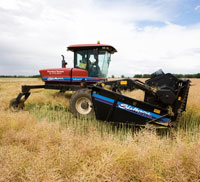HGCA looks into OSR wilt threat

Shorter rotations and early drilling could increase the risk of verticillium wilt on oilseed rape, warned ADAS plant pathologist Dr Peter Gladders
But little is known about the soil-borne disease, which is why a new HGCA project was launched in January to examine the threat.
The disease is characterised by crops dying off early. Growers should look for long, grey streaks on stems either leading up to, or even after swathing or desiccation.
First confirmed in the UK in 2007, verticillium wilt causes significant losses of oilseed rape in parts of northern Europe, which was where most current knowledge of the disease had been gathered, Dr Gladders said.
Trials in Germany, for example, had found that tightening rotations to one oilseed rape crop per three seasons from a one in four rotation doubled the amount of inoculum in the soil, and increased disease levels by almost 50%.
“If you have any verticillium, you really need to be looking at a least 1 in 4 rotation, preferably longer,” he said.
Similarly, increasing the length of the growing season from 45 weeks by a couple of weeks also doubled inoculum, showing the potential danger from early drilling, he noted.

